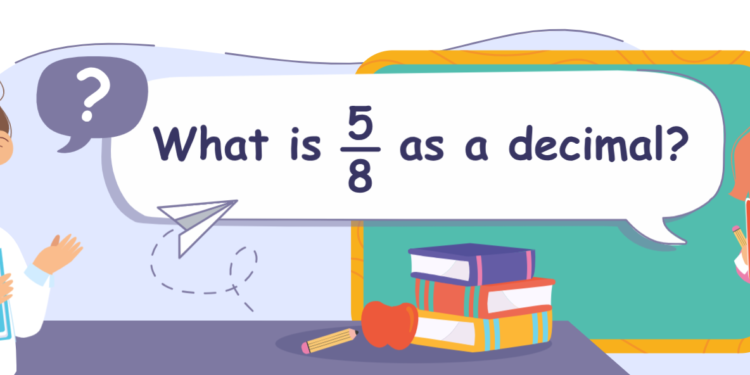A crucial mathematical talent that enables us to express fractional quantities in decimal form is the ability to convert fractions to decimals. 5/8 as a decimal. In this case, we will restore the fraction 5/8 into a decimal. We may determine the decimal equivalent by dividing the numerator (five) by the denominator (eight). After performing the division, the result is 0.625. Thus, the decimal representation of 5/8 is 0.625. Understanding how to convert fractions to decimals expands our numerical repertoire and facilitates calculations in various contexts, making it a valuable skill.
Fraction Basics: What is 5/8?
Fractions are a fundamental mathematical concept, representing a part of a whole or a division of quantities. The fraction’s numerator 5/8 is five, and the denominator is 8. The denominator denotes the total number of equally spaced components that make up the whole, whereas the numerator indicates the number of parts we have or want to consider.
In the case of 5/8, the numerator is 5, indicating that we have five parts of the whole or five units of the quantity. The denominator is 8, meaning the whole is divided into eight equal parts or eight teams. 5/8 as a decimal
Fractions allow us to express values between whole numbers, indicating portions or ratios. They are commonly used in various real-life scenarios, such as measurements, proportions, and comparisons.
Understanding fractions is crucial for everyday tasks, ranging from cooking and measurements to scientific, engineering, and finance calculations. Being able to interpret and manipulate bits helps us solve problems, make accurate calculations, and communicate precise information.
In summary, the fraction 5/8 represents five parts out of eight equal pieces. A solid understanding of fraction basics enables us to navigate mathematical operations, solve problems, and interpret the world more effectively.
Converting Fractions to Decimals: The Process Unveiled
Converting fractions to decimals is a fundamental mathematical skill allowing us to express fractional values in decimals. This process provides a more precise and convenient representation for specific calculations and comparisons. Let’s walk through the process of converting fractions to decimals step by step.
We divide the numerator, top number, by the denominator, or bottom number, to convert a fraction to a decimal. Taking the example of 5/8, we divide five by 8. The division gives us a result of 0.625.
The decimal form of 5/8 is 0.625. It indicates that the fraction 5/8 is equivalent to the decimal value 0.625. This suggests that 5/8 would lie between 0.5 and 0.75 on a number line if represented numerically.
Converting fractions to decimals is particularly useful when dealing with calculations involving mixed numbers, ratios, and proportions. It simplifies mathematical operations and allows for easier comparisons.
You Can Read This Simler Article: 150 USD to CAD
Understanding how fractions are converted to decimals allows us to work with numbers more efficiently and accurately. This skill enhances our mathematical fluency and enables us to navigate mathematical concepts and real-life situations.
Mastering the conversion of fractions to decimals expands our mathematical toolkit and empowers us to make precise calculations, interpret numerical data, and solve problems effectively.
Step-by-Step Conversion: Converting 5/8 to a Decimal
Mathematicians need to be able to convert fractions to decimals because it gives them a mechanism to express fractional quantities in decimal form. This article will explore the step-by-step process of converting the fraction 5/8 into a decimal. 27″ Iiyama G-Master GB2760HSU-B1
- Step 1: Divide the numerator by the denominator. In this case, divide five by 8: 5 ÷ 8 = 0.625.
- Step 2: Interpret the quotient. The quotient obtained from the division, 0.625, represents the decimal equivalent of the fraction 5/8.
- Step 3: Understand the decimal representation. The decimal 0.625 can be read as “zero point six two five” or “six hundred twenty-five thousandths.”
I am converting 5/8 to decimal yields the result of 0.625. This decimal representation allows for more straightforward calculations, comparisons, and mathematical operations.
For tackling various mathematical issues and real-world scenarios, it is crucial to comprehend the step-by-step conversion method from fractions to decimals. It provides a precise and versatile representation of values, enabling efficient mathematical reasoning and analysis.
By mastering the conversion of fractions to decimals, individuals enhance their numerical fluency, problem-solving skills, and ability to interpret and communicate mathematical concepts effectively.
Practical Applications: Utilizing Decimal Equivalents for Simplified Calculations
The conversion of fractions to decimals is vital in various practical applications, offering simplified calculations and facilitating problem-solving. Using decimal equivalents, we can streamline mathematical operations and make them more efficient. Let’s explore some practical applications where decimal equivalents prove invaluable.
- Measurement Conversions: When converting between different units of measurement, decimal equivalents allow for straightforward calculations. For instance, it is easier to translate from 0.5 feet to inches than from 1/2 feet to inches. Decimal equivalents eliminate the need for complex fraction manipulations, enabling quicker and more accurate conversions.
- Financial Calculations: In finance and accounting, decimal equivalents are extensively used for interest rate calculations, currency conversions, and financial modeling. Decimal representations ensure precision and consistency in monetary measures, providing reliable results for budgeting, investments, and financial planning.
- Recipe Scaling: Decimal equivalents simplify recipe scaling, especially when adjusting ingredient quantities. It is simpler to scale a recipe for 3/4 cup of flour by multiplying 0.75 cups by the necessary factor. Decimal equivalents allow for precise adjustments without fraction conversions, making recipe scaling more efficient.
- Engineering and Construction: In engineering and construction fields, decimal equivalents are essential for accurate measurements, blueprints, and material estimations. Working with decimals enables precise calculations, minimizing errors and ensuring project integrity.
Using decimal equivalents, we unlock a practical and efficient approach to mathematical calculations in various real-world scenarios. Understanding and applying decimal equivalents empowers us to confidently navigate measurements, financial transactions, and other quantitative tasks, enhancing our problem-solving skills and improving accuracy in practical applications.
Also, Read The Following: 4x ^ 2 – 5x – 12 = 0











Discussion about this post